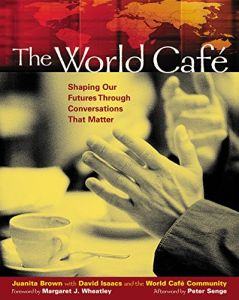Join getAbstract to access the summary!

Join getAbstract to access the summary!
Juanita Brown and David Isaacs
The World Café
Shaping Our Futures Through Conversations That Matter
Berrett-Koehler, 2005
What's inside?
Egalitarian dialogue is dawning as a major way to strategize and solve problems as top-down change methods are waning.
Recommendation
Authors David Isaacs and Juanita Brown came up with the idea for the World Café when they tried to rescue a meeting in their home that was threatening to turn into a disaster. Leaders from the Skandia Corporation were supposed to have a discussion on their northern California home’s beautiful patio. Unfortunately, it was pouring. Brown and Isaacs had to squeeze 24 Swedes into their living room. They hastily covered small TV tables with sheets of newsprint anchored with small flower vases. Soon, the place looked like a coffee shop. The delighted guests began conversing immediately, eventually moving among the small groups to hear what others had to say. Thus, the World Café movement was born. Isaacs and Brown include many stories about ways that organizations have used World Café conversations. They provide lists, drawings and discussion questions. Brown’s commentary on process and principles weaves all this together. She makes grand claims for this approach, believing that conversation is the wave of the future and the best way for people to learn and change. Jargon alert: the authors truly adore New Age gobbledygook. One example suffices: “Optimum learning and development occur in systems in which there is a rich web of interactions, along with an environment of novelty where new opportunities and spaces of possibility can be explored.” Despite such warm-hearted mush, getAbstract.com recommends this book to managers who are willing to experiment with an innovative meeting format that lets them synthesize experts’ ideas with the experiences of their own people.
Summary
About the Authors
Juanita Brown and David Isaacs originated the World Café. Brown consults for Fortune 100 companies, governments and nonprofits, and is a senior affiliate of the Society for Organizational Learning at the Massachusetts Institute of Technology Sloan School of Business. Isaacs is president of Clearing Communications, an organizational strategy consultancy that works with senior executives.
















Comment on this summary